Here the low power 12V transformerless power supply circuit with full-wave rectification. A lot of circuits could be powered straightaway in the electric mains using the support of a series capacitor (C1). The problem with this method is the fact that typically only one half cycle of the mains wave-form can be used to deliver a DC voltage. An obvious option is to work with a bridge rectifier to accomplish full-wave rectification, which improves the amount of current that can be delivered and makes it possible for the filter capacitor to become smaller sized. The associated circuit in fact does this, but in a clever manner that makes use of fewer parts. Right here we take benefit of the reality that a Zener diode can also be a standard diode that conducts electric current in the forward direction. During one half wave, the current flows via D1 through the load and back via D4, whilst during the other half wave it flows via D3 and D2. Keep in mind that with this circuit (and with the bridge rectifier version), the zero voltage reference of the DC voltage is not directly connected towards the neutral line of the 230V circuit.
This means that it is mostly not possible to work with this kind of supply to drive a TRIAC, that normally requires such a connection. Even so, circuits that utilize relays can benefit from full-wave rectification. The value of the supply voltage depends on the specifications of the Zener diodes which are applied, which can be freely selected. C2 have to be able to deal with at least this voltage. The level of current which can be supplied will depend on the capacitance of C1. With the given value of 220nF, the current is about 15mA. A final warning: this kind of circuit is directly connected to mains voltage, which can be lethal. You must certainly not come in get in touch with with this circuit directly without safety equipment! It is critical to mount this circuit safely and securely inside a appropriate case.

Comments